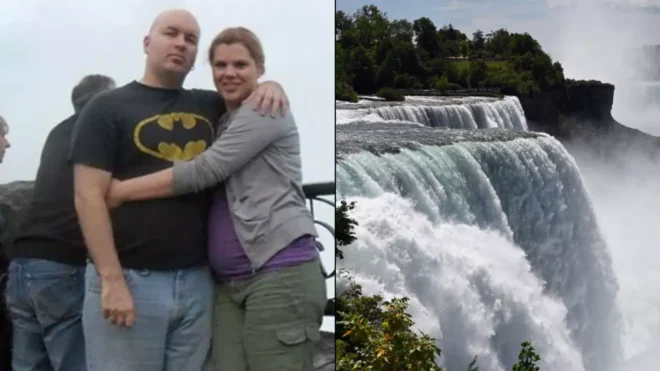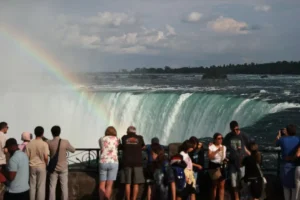
An unassuming photo of two tourists standing together at Niagara Falls would go on to become famous as it revealed a woman’s final moments before tragedy struck.
One of many outstanding natural beauty spots in North America, Niagara Falls straddles the boarder between the US state of New York and Canada, attracting approximately 12 million visitors every year.
With an insanely high amount of footfall, it means that tourists sometimes have to go to extreme lengths in order to get their perfect photo, which can lead to devastating consequences.

It’s believed that around 5000 people have fallen into the famous landmark – either intentionally or accidentally – since 1850, with only 16 people reported to have survived the plunge.
On 14 August 2011, Canadian couple Andrea Smith and Jason Watson were visiting the falls and posed for a photo together in front of the popular Horseshoe Falls section of the national park, which lies just over the Canadian side of the boarder.
The couple would get there photo taken together at the viewpoint and while the image looks like any other tourist photo taken in the region, it was actually captured seconds before disaster.
On the upper left-hand side of the photo, a woman dressed in red and be seen stood up, seemingly crossing over the railing separating visitors from the drop. This woman was 20-year-old Ayano Tokumasu and her story would go on to serve as a tragic warning for anyone considering ignoring safety regulations to get the perfect photo.
Originally from Japan, Tokumasu was an exchange student attending an Toronto’s Hansa Language Centre in Ontario and had decided to visit the attraction on this fateful day.
Visiting the site with a friend, Tokumasu hopped over the railing so her friend could get a picture of her without other people in the background. However, when she attempted to climb back over to safety the student lost her balance, fell backwards into the water and was swept away.
Eyewitnesses on the day would state that Tokumasu appeared to be straddling the railings in order to get a better view of the scenery. It would take another four days before Tokumasu’s body was located and recovered from the deep waters.
Smith would later speak out about unintentionally capturing her last moments on camera, telling Canadian newspaper Windsor Star (via Huffpost): “It actually gave me a chill [looking at the photo].
“We could have done something to save her and we didn’t.”
The tragic story of Ayano Tokumasu at Niagara Falls serves as a grim reminder of the dangers that lurk in even the most beautiful of places. Her untimely death, captured inadvertently in a photo, has since become a cautionary tale for tourists worldwide. This incident sheds light on the often-overlooked risks associated with seeking the perfect photograph and emphasizes the importance of adhering to safety guidelines, especially in environments where natural beauty is coupled with inherent danger.
Niagara Falls is one of the most iconic natural wonders of the world. Straddling the border between the United States and Canada, the falls have drawn millions of visitors for centuries, captivated by the sheer power and beauty of the cascading waters. Comprising three waterfalls—the Horseshoe Falls, the American Falls, and the Bridal Veil Falls—Niagara Falls is a breathtaking spectacle, with the Horseshoe Falls being the largest and most renowned. The mist rising from the falls, the thunderous roar of the water, and the vibrant rainbows that often form in the spray create a mesmerizing scene that many visitors wish to capture on camera.
However, the very elements that make Niagara Falls so awe-inspiring also contribute to its peril. The sheer force of the water, which flows at an average of 85,000 cubic feet per second, and the deep, swirling pools below make the area around the falls extremely hazardous. Despite the presence of railings and warning signs, the desire to get an unobstructed view or a unique photo often leads tourists to venture too close to the edge, sometimes with fatal consequences.
On that fateful day in August 2011, Ayano Tokumasu, a 20-year-old Japanese exchange student, visited Niagara Falls with a friend. Like many visitors, she was enchanted by the beauty of the falls and wanted to capture a memorable photograph. However, what was meant to be a joyful experience quickly turned into a nightmare.
Tokumasu and her friend decided to visit the Horseshoe Falls, a popular spot on the Canadian side of the border. The Horseshoe Falls is known for its dramatic curve and the powerful flow of water that plunges 167 feet into the Niagara River below. It is one of the most photographed spots in the region, attracting tourists who are eager to capture the majesty of the falls.
To get a better view and avoid having other people in the background of her photo, Tokumasu made the fatal decision to climb over the protective railing. Her intention was simple: to capture a photograph that would perfectly encapsulate her experience at one of the world’s most famous landmarks. But in doing so, she put herself in a position of extreme danger.
As she straddled the railing, likely unaware of just how precarious her situation was, Tokumasu lost her balance. In an instant, she fell backwards into the water, where the powerful current quickly swept her away. Her friend, along with other onlookers, could only watch in horror as she disappeared into the churning waters below.
The search for Tokumasu’s body was intense and somber, with authorities scouring the area for days. Her body was finally recovered four days later, bringing a tragic end to what was supposed to be a day of joy and exploration. The image taken by Andrea Smith and Jason Watson became a haunting reminder of the moment just before Tokumasu’s life was cut short. In the photo, Tokumasu can be seen standing on the edge, just seconds away from falling to her death.
Smith, who had unintentionally captured Tokumasu’s last moments, later expressed deep sorrow and a sense of helplessness, wishing she could have done something to prevent the tragedy. Her statement reflects the collective feeling of regret that often accompanies such incidents, where bystanders are left to grapple with the “what ifs” and the harsh reality that some accidents are simply beyond anyone’s control.
The tragedy of Ayano Tokumasu is a stark reminder of the importance of safety and caution, especially in natural settings where the environment can quickly turn dangerous. While the allure of capturing the perfect photo is strong, it is vital to remember that no picture is worth risking one’s life. The protective barriers and warning signs at places like Niagara Falls are there for a reason—they are designed to keep visitors safe from the unpredictable and often deadly forces of nature.
Tokumasu’s story has resonated with many, serving as a powerful cautionary tale. It has prompted discussions about the need for increased safety measures and awareness, especially in tourist-heavy areas where people might be tempted to take risks for the sake of a photograph. In the age of social media, where the pressure to capture and share stunning images is greater than ever, it is crucial to prioritize safety over aesthetics.
The incident also raises broader questions about the human tendency to prioritize visual documentation over personal safety. In recent years, the phenomenon of “dangerous selfies” has become increasingly common, with individuals putting themselves in harm’s way to take photos in extreme or perilous locations. This trend has led to a number of accidents and fatalities worldwide, as people attempt to push the boundaries of what is considered a “great shot.”
In response, some regions have implemented stricter regulations and increased signage to warn visitors of the dangers of certain actions, such as climbing over railings or getting too close to cliff edges. Additionally, there have been calls for more educational campaigns to raise awareness about the risks associated with certain behaviors in natural and tourist environments.
While the story of Ayano Tokumasu is undeniably tragic, it has also left a lasting impact on those who hear it. Her death is a poignant reminder of the fragility of life and the importance of exercising caution in all situations. It serves as a powerful warning to others, encouraging them to think twice before taking unnecessary risks in pursuit of a photograph.
In the years since her death, the story of Tokumasu has been shared widely, often as part of discussions about tourist safety and the dangers of ignoring safety protocols. Her story is a testament to the fact that even in the most beautiful and seemingly safe environments, danger can lurk just beneath the surface.
Niagara Falls remains one of the most visited natural attractions in the world, drawing millions of people each year. However, the memory of Ayano Tokumasu serves as a sobering reminder that while nature’s beauty can be mesmerizing, it must also be respected. Her tragic end is a story that will continue to be told, not just as a warning, but as a reminder of the importance of valuing life over the pursuit of the perfect image.